Published online by Cambridge University Press: 02 June 2005
Since their discovery, laser accelerated ion beams have been the subject of great interest. The ion beam peak power and beam emittance is unmatched by any conventionally accelerated ion beam. Due to the unique quality, a wealth of applications has been proposed, and the first experiments confirmed their prospects. Laser ion acceleration is strongly linked to the generation and transport of hot electrons by the interaction of ultra-intense laser light with matter. Comparing ion acceleration experiments at laser systems with different beam parameters and using targets of varying thickness, material and temperature, some insight on the underlying physics can be obtained. The paper will present experimental results obtained at different laser systems, first beam quality measurement on laser accelerated heavy ions, and ion beam source size measurements at different laser parameters. Using structured targets, we compare information obtained from micro patterned ion beams about the accelerating electron sheath, and the influence of magnetic fields on the electron transport inside conducting targets.
The advent of ultra-intense laser systems (Perry & Mourou, 1994) has opened the regime of relativistic plasma physics, leading to a multitude of new and exciting phenomena like laser induced nuclear transmutation (Santala et al., 2001), high harmonics generation, and megagauss magnetic fields. One of the most interesting new phenomena was the generation of ultra-intense, high-energetic electron beams (Key et al., 1998), which penetrate deep inside the irradiated target. Because of the importance for applications like isochoric heating or fast ignition in inertial confinement fusion (Tabak et al., 1994), the transport of these electrons into the matter is a subject of extended research worldwide (Martinolli et al., 2002; Bell et al., 1997). The recent discovery of intense, well-collimated, picosecond-duration ion beams being generated by these electrons in laser solid interaction (Clark et al., 2000; Snavely et al., 2000; Hegelich et al., 2002), has raised the hope to use the ion beam in order to explore the electron transport (Fuchs et al., 2003). Moreover, because of the unique properties of the laser produced ion beams, and the close correlation to the transport of the electrons inside the target, the investigation of the latter is vital in order to control the beam properties for applications like diagnostics for high temperature plasmas (Borghesi et al., 2002), proton based fast ignition (Roth et al., 2001), material science (Boody et al., 1996), and as next generation ion sources for high energy physics (Haseroth & Hill, 1996).
Laser accelerated proton and ion beams offer a tool for precise measurements of the distribution of energetic electron component, because of their intrinsic low emittance (Cowan et al., 2004). The excellent beam quality allows for the detection of small variations in electron distribution at the rear, non-irradiated surface of the target.
At Gesellschaft für Schwerionenforschung (GSI), research has focused on the interaction of energetic heavy ions with plasma, in order to explore the regime of strongly coupled plasma (Hoffmann et al., 2005). Having noticed the advantage of the unique combination of an intense laser with a powerful heavy ion beam, GSI has started to build a petawatt high energy laser for ion experiments (PHELIX). In recent years, we have reported on measurements of the ion beam quality (Roth et al., 2002), and have developed a technique to precisely determine the ion beam emittance and energy spread. Using this technique, we have been able to determine the real ion beam source size at the rear surface of the target, and deviations of the electron density distribution.
Thin foils irradiated by ultra-intense laser beams at intensities in the order of 1019 W/cm2, generate intense bursts of ions off the rear surface, propagating normally to the rear surface orientation. It is common understanding that the high laminarity, or low emittance, of these beams stems from the fact that the acceleration process takes place on the rear, non irradiated surface of the target. There, a dense, relativistic electron sheath is formed by the laser-accelerated electrons that have propagated through the target. The sheath produces an electrostatic field >1012 V/m that ionizes the surface atoms almost instantaneously, forming a ∼1 nm thick ion layer which, together with the electron sheath, resembles a virtual cathode (Ruhl et al., 2004).
There are other mechanism which also produce forward-accelerated ions, although in lower numbers, and at lower energies. Protons having the largest charge-to-mass ratio and originating from target surface contamination (water vapor and hydrocarbons), are preferentially accelerated in favor of heavier ions over a distance of a few microns, and up to tens of MeV. In typical experiments this forms a collimated beam with an approximately Maxwellian energy distribution at kT = 5–6 MeV. The extremely strong, transient acceleration taking place from an initially cold, unperturbed surface, results in the low beam emittance that seems to be limited only by the collisions with the co-moving electrons during the acceleration.
The transport of relativistic electrons through the target is an intensively studied research area because of its relevance not only for ion acceleration, but especially for the concept of fast ignition in inertial confinement fusion (Deutsch, 2004; Honrubia et al., 2004). The transport of large currents through the target, the problem of beam filamentation, and the dependence on the target conductivity (with respect to the onset of return currents) are essential for a detailed understanding of the ion acceleration. One crucial parameter for the electron transport has been found to be the target conductivity (Wharton et al., 1998). Anomalous stopping has been investigated experimentally and theoretically using plastic and metal targets (Pisani et al., 2000). In the experiments, special care must be taken to avoid extensive pre-pulses or large amounts of amplified spontaneous emission (ASE). The preceding ASE launches a shock wave into the target altering the initial conditions via shock wave heating thereby changing the target density and resistively.
Experiments have been performed at different laser systems varying the on-target intensity, pulse length, and target thickness by at least an order of magnitude. For this purpose we carried out experiments at the 100 TW laser system at Laboratoire pour l'Utilisation des Lasers Intense (LULI) (30 J at 300 fs, 5 × 1019 W/cm2), at the Rutherford petawatt laser system (RAL) (500 J at 500 fs, 2 × 1020 W/cm2), and at the 30 TW Los Alamos Trident laser system (30J at 850 fs, 7 × 1018 W/cm2). A typical diagnostic setup is depicted in Figure 1. A screen of radiochromic film (RCF) was positioned a few cm behind the target to record the spatial beam profile. The RCF changes through polymerization of a diacetylene active layer, from transparent to dark blue in proportion to the absorbed dose (rads) of ionizing radiation. In certain experiments, a slot in the RCF allowed a free line of sight from the target to the particle spectrometers to measure the energy distribution of the emitted particles.

Experimental setup. The free standing target is irradiated at normal incidence. A slit in the Radiochromic film gives a line of sight for the particle spectrometers.
The target consisted of gold, aluminium, and plastic foils of millimeter size, and varying thickness from 5 to 100 μm. For heavy ion acceleration, we used thin titanium foils, which have been coated with the material of interest at the rear surface, and have been heated to several hundred degrees in order to remove the proton containing contaminants. Several attempts have been made to measure the beam emittance or the corresponding source size by using projection, on a far distant film, objects like knife-edges or meshes placed in the beam path. However, due to charging effects of the obscuring object and deviations of the ion trajectories from a pure, ballistic propagation, the beam emittance cannot be reconstructed precisely from such measurements.
The technique we have developed to overcome these limitations uses a target design that allows manipulating the ion beam generation during the initial, virtual-cathode phase of the acceleration by generating a stream of beamlets, within the expanding proton envelope, that can be used as fiducially of the acceleration.
The laminarity of charged-particle beams is characterized by their emittance, which is proportional to the volume of the bounding ellipsoid of the distribution of particles in phase space. For the transverse phase-space dimensions (here, x-px for beam propagation along z), the area of the bounding phase-space ellipse equals πεN, where the root-mean-square (rms) value of the “normalized emittance” εN, at a specific beam energy (or momentum p), is expressed as εN = (| p|/mc)[〈x2〉〈x′2〉 − 〈xx′〉2]1/2 where m is the ion mass, c is the velocity of light, x is the particle position within the beam envelope, and x′ = px/pz is the particles' divergence in the x-direction. At a beam waist, εN = βγσx σx′ where σx and σx′ are the rms values of the beam width and divergence angle. For typical proton accelerators (that is, the CERN SPS), the emittance from the proton injector linac is ∼1 mm-mrad (normalized-rms). The longitudinal phase-space (z-pz) is characterized by the equivalent, energy-time product of the beam. The highest quality ion beams have the lowest values of transverse and longitudinal emittance, indicating a low effective transverse ion temperature and a high degree of angle-space and time-energy correlation.
The data in Figure 2 were obtained using optically flat aluminium foils on the rear surface of which we micro-machined shallow grooves, 200 nm deep, and spaced 3.6 μm apart. The grooves appear to electrostatically focus the protons near the target surface to individual beamlets after which the expanding sheath produces a correlation between the initial source position and final divergence angle. By accelerating protons off non-periodic surface structures, we verified that there is no overlap from adjacent structures that could lead to misinterpretation of the data.
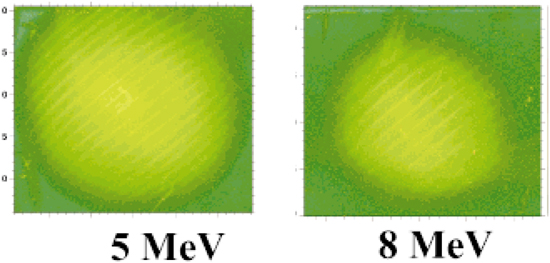
Spatial distributions at different energies of protons accelerated from a Al flat target detected on the RCF film stack. Micro-focused beam-fiducials map the emission zone at the virtual cathode, which decreases at higher proton energy.
We experimentally deduce an upper limit for the transverse beam emittance for the different laser systems and, for the first time, for ions other than protons. Table 1 gives a summary of the measurements and the resulting upper limits. The low values for the beam emittance are in agreement with the cold temperature of the ions at the rear of the target. The measured values are up to a factor of 100 better than typical ion beam sources. We attribute this to the fact that during much of the acceleration, the ion beam space charge is compensated and neutralized by the co-moving electrons, and that the sheath electric field self-consistently evolves with the ions to produce an effectively ideal accelerating structure. For protons above 4.5 MeV, the decrease in the angular envelope with energy is due to a decrease of the emitting zone, but not due to a strong change in the divergence of the beam envelope or from magnetic field deflection.
Upper limits on the normalized ion beam emittance for different laser systems
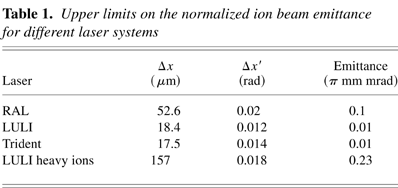
The experiments show that the highest energy protons are emitted in the central, high density portion of the sheath distribution, and thus, are emitted at larger angle. Figure 3 shows the change in source size for different proton energies in a typical experiment. The actual source size is much bigger than the one obtained using penumbral imaging techniques, but consistent with recent measurements using charged particle beam imaging of the accelerating sheath with laser accelerated proton beams. Comparing the source size for different laser systems, it is interesting to note that there seems to be a clear correlation between the energy of the protons, compared to their maximum energy and the source size. This correlation is almost independent of the laser energy or intensity and target thickness. In agreement with recent experimental results as well as with numerical investigations, the electron transport in isolating targets is limited by self-generated electric fields and subject to filamentation and beam break-up of the electrons that penetrate into the target. The filamented electron transport then causes the ion acceleration to be modified as has been published already (Roth et al., 2002).
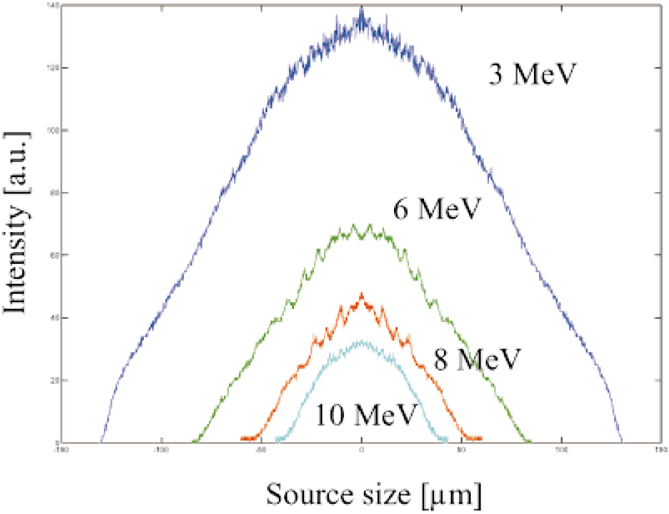
Real source size of the laser accelerated protons for different proton energies. The size at the rear surface decreases from 260 μm for 3 MeV protons to 80 μm for 10 MeV protons.
In contrast to the transport in non-conducting targets, the electron transport in metal foils seems to be free from instabilities. Comparing the real source size of the ions versus different target thickness and laser intensities, no influence of self-generated magnetic fields could be observed.
A detailed analysis of the ion beam patterns obtained from micro-structured targets can give additional information about the shape of the electron sheath. Many ion bunches show a deformation in the grating pattern at the transverse ion beam edges. These deformations allows for conclusions on the accelerated proton layer at early stages and therefore on the shape of the accelerating electron sheath. A simple analytical model shows that an ideal image of the pattern is obtained for a parabolic electron sheath. The measured deviations from the ideal case are very small for the laser systems used in the context of this paper. Details on the model and the results will be published elsewhere.
Micro-structured targets directly correlate a point on the target surface to the corresponding point on the detector. This allows not only for the determination of the real source size, but also for the divergence angle for different ion energies, and finally the point where the ions “seem” to come from the virtual source point. The idea is depicted in Figure 4. Due to the fact that the protons propagate in almost straight lines from the source to the detector, and that the pattern is well reproduced, backward ray-tracing can determine a point from where the protons seem to originate. The point is determined by the initial shape of the proton layer at the beginning of the acceleration. Despite a lack of direct physical meaning, it is interesting to note that this point is always located in front of the target at a distance of between 50–200 μm. Finally it is also interesting to note that the overall shape of the ion beam also can be modified by direct laser imprint. Using strongly astigmatic foci we could change the shape of the ion beam as can be seen in Figure 5.
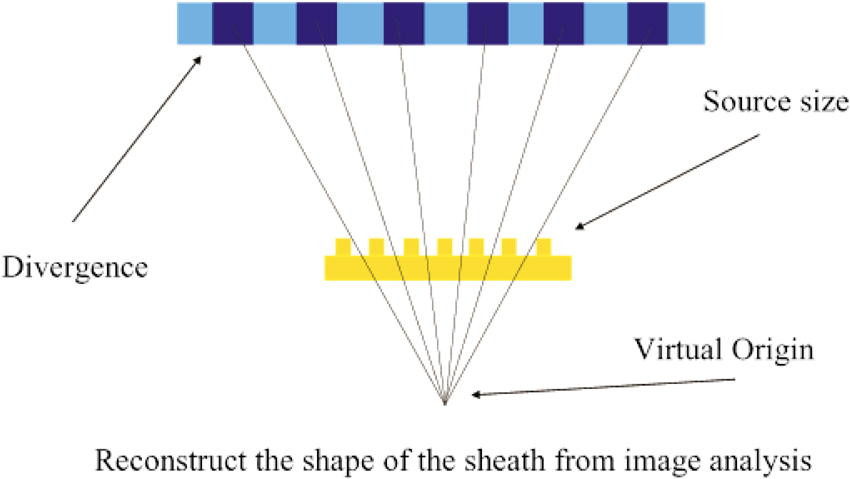
Basic concept of the detailed ion beam analysis. Based on micro-structured beams and a direct correlation between source and image the shape of the sheath can be reconstructed.
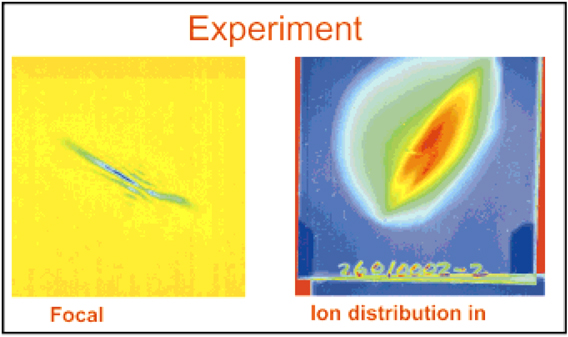
(left) Astigmatic laser focus on a smooth 48 μm thick Au target at ∼4 × 1018 W/cm2. (right) Distribution of protons in RCF in this experiment.
The transport of large amount of energetic electrons through laser irradiated targets is important for many applications in ultra-intense laser-matter interaction. Laser accelerated, low emittance ion beams that are driven by the energetic electron component can give important additional information about the physics of the electron transport due to the sensitivity of the electron density distribution. Using the technique of micro-structured targets and comparing experiments at different laser systems, we investigated the shape of the electron density distribution, the laminarity of the sheath evolution, resulting in a low ion beam emittance, and the electron beam transport break-up in isolating targets. The results show a high degree of similarity between the different laser systems even though the energy, intensity, and the target thickness has been varied up an order of magnitude. This indicates the transport and acceleration mechanism to be quite robust versus a change in the parameter, whereas it is very sensitive to a change in the target conductivity.
We acknowledge the expert support of the LULI, RAL, and Trident laser teams. This work was supported by grant E1127 from Région Ile-de-France, EU program HPRI CT 1999-0052, LANL Laboratory Directed Research & Development, corporate support of General Atomics and UNR grant DEFC08-01NV14050.

Experimental setup. The free standing target is irradiated at normal incidence. A slit in the Radiochromic film gives a line of sight for the particle spectrometers.

Spatial distributions at different energies of protons accelerated from a Al flat target detected on the RCF film stack. Micro-focused beam-fiducials map the emission zone at the virtual cathode, which decreases at higher proton energy.
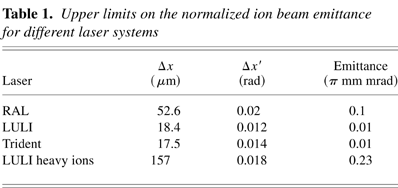
Upper limits on the normalized ion beam emittance for different laser systems
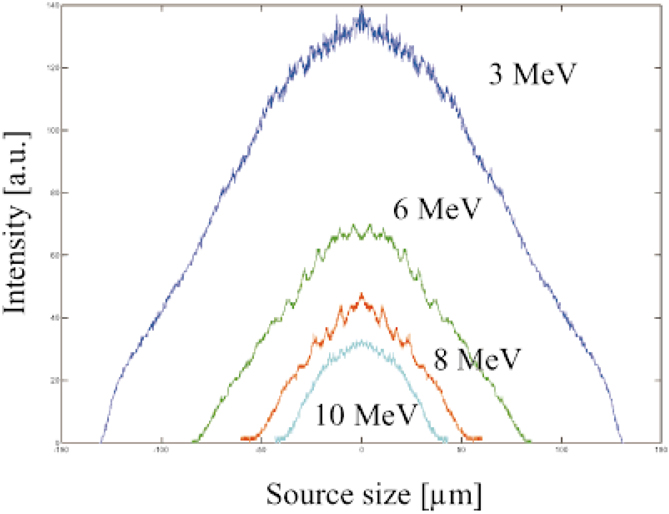
Real source size of the laser accelerated protons for different proton energies. The size at the rear surface decreases from 260 μm for 3 MeV protons to 80 μm for 10 MeV protons.

Basic concept of the detailed ion beam analysis. Based on micro-structured beams and a direct correlation between source and image the shape of the sheath can be reconstructed.
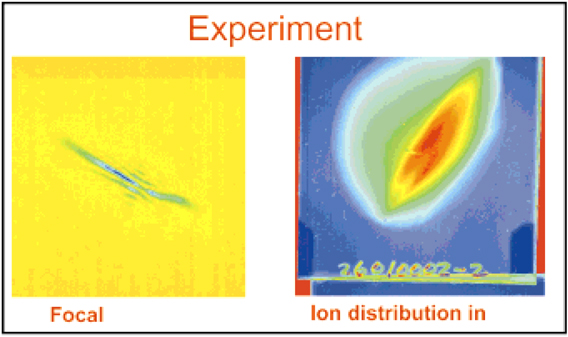
(left) Astigmatic laser focus on a smooth 48 μm thick Au target at ∼4 × 1018 W/cm2. (right) Distribution of protons in RCF in this experiment.